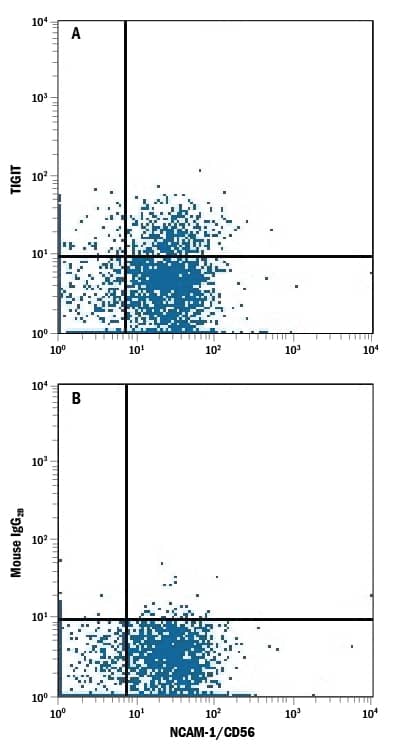Human TIGIT Alexa Fluor® 700-conjugated Antibody
R&D Systems, part of Bio-Techne | Catalog # FAB7898N


Key Product Details
Species Reactivity
Validated:
Cited:
Applications
Validated:
Cited:
Label
Antibody Source
Product Specifications
Immunogen
Met1-Pro141
Accession # Q495A1
Specificity
Clonality
Host
Isotype
Scientific Data Images for Human TIGIT Alexa Fluor® 700-conjugated Antibody
Detection of TIGIT in Human PBMC lymphocytes by Flow Cytometry.
Human peripheral blood mononuclear cell (PBMC) lymphocytes were stained with Mouse Anti-Human NCAM-1/CD56 PE-conjugated Monoclonal Antibody (Catalog # FAB2408P) and either (A) Mouse Anti-Human TIGIT Alexa Fluor® 700-conjugated Monoclonal Antibody (Catalog # FAB7898N) or (B) Mouse IgG2BAlexa Fluor 700 Isotype Control (Catalog # IC0041N). View our protocol for Staining Membrane-associated Proteins.Applications for Human TIGIT Alexa Fluor® 700-conjugated Antibody
Flow Cytometry
Sample: Human peripheral blood mononuclear cell (PBMC) lymphocytes
Formulation, Preparation, and Storage
Purification
Formulation
Shipping
Stability & Storage
Background: TIGIT
TIGIT (T cell Immunoreceptor with Ig and ITIM domains), also called Vstm3 (V-set and transmembrane domain-containing 3), Vsig9 (V-set and Ig domain-containing 9) and WUCAM (Washington University cell adhesion molecule) is a 30-34 kDa type I transmembrane protein that is a member of the CD28 family within the Ig superfamily of proteins (1-4). Human TIGIT cDNA encodes 244 amino acids (aa) including a 21 aa signal sequence, a 120 aa extracellular region with a V-type Ig-like domain and two potential N-glycosylation site, a 21 aa transmembrane sequence, and an 82 aa cytoplasmic domain with an ITIM motif (5). A 170 aa variant diverges after aa 166 (5). Within the ECD, human TIGIT shares only 68-75% aa sequence identity with mouse, porcine, canine, equine and bovine TIGIT. TIGIT is expressed on NK cells and subsets of activated, memory and regulatory T cells, and particularly on follicular helper T cells within secondary lymphoid organs (1, 2, 6-8). It binds to CD155/PVR/Necl-5 and Nectin-2/CD112/PVRL2 that appear on dendritic cells (DC) and endothelium (1-3, 7). Binding of TIGIT by DC induces IL-10 release and inhibits IL-12 production (2). Ligation of TIGIT on T cells down‑regulates TCR-mediated activation and subsequent proliferation, while NK cell TIGIT ligation blocks NK cell cytotoxicity (6-8). Through CD155 and Nectin-2, which also interact with DNAM-1/CD226 and CD96/Tactile, TIGIT is part of an interacting network of Ig superfamily members that may augment or oppose each other (3, 4, 6, 7). In particular, TIGIT binding to CD155 can antagonize the effects of DNAM-1 (6, 7). Soluble TIGIT is able to compete with DNAM-1 for CD155 binding and attenuates T cell responses, while mice lacking TIGIT show increased T cell responses and susceptibility to autoimmune challenges (2, 3, 8).
References
- Boles, K.S. et al. (2009) Eur. J. Immunol. 39:695.
- Yu, X. et al. (2009) Nat. Immunol. 10:48.
- Levin, S.D. et al. (2011) Eur. J. Immunol. 41:902.
- Xu, Z. et al. (2010) Cell. Mol. Immunol. 7:11.
- SwissProt Accession # Q495A1.
- Seth, S. et al. (2009) Eur. J. Immunol. 39:3160.
- Stanietsky, N. et al. (2009) Proc. Natl. Acad. Sci. USA 106:17858.
- Joller, N. et al. (2011) J. Immunol. 83:1338.
Long Name
Alternate Names
Gene Symbol
UniProt
Additional TIGIT Products
Product Specific Notices for Human TIGIT Alexa Fluor® 700-conjugated Antibody
This product is provided under an agreement between Life Technologies Corporation and R&D Systems, Inc, and the manufacture, use, sale or import of this product is subject to one or more US patents and corresponding non-US equivalents, owned by Life Technologies Corporation and its affiliates. The purchase of this product conveys to the buyer the non-transferable right to use the purchased amount of the product and components of the product only in research conducted by the buyer (whether the buyer is an academic or for-profit entity). The sale of this product is expressly conditioned on the buyer not using the product or its components (1) in manufacturing; (2) to provide a service, information, or data to an unaffiliated third party for payment; (3) for therapeutic, diagnostic or prophylactic purposes; (4) to resell, sell, or otherwise transfer this product or its components to any third party, or for any other commercial purpose. Life Technologies Corporation will not assert a claim against the buyer of the infringement of the above patents based on the manufacture, use or sale of a commercial product developed in research by the buyer in which this product or its components was employed, provided that neither this product nor any of its components was used in the manufacture of such product. For information on purchasing a license to this product for purposes other than research, contact Life Technologies Corporation, Cell Analysis Business Unit, Business Development, 29851 Willow Creek Road, Eugene, OR 97402, Tel: (541) 465-8300. Fax: (541) 335-0354.
For research use only